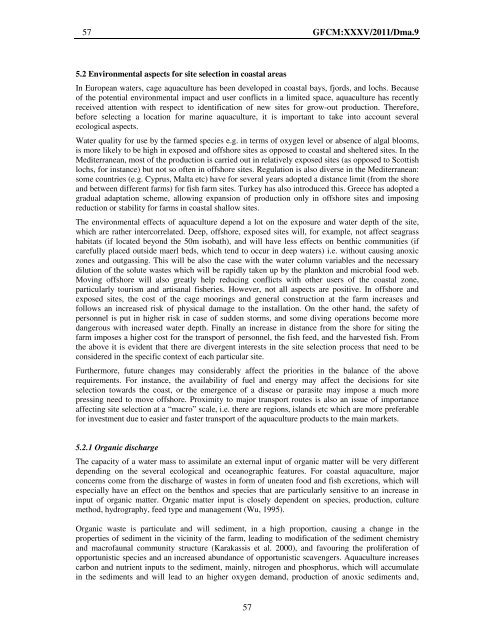Site selection and carrying capacity in Mediterranean ... - FAO Sipam
Site selection and carrying capacity in Mediterranean ... - FAO Sipam
Site selection and carrying capacity in Mediterranean ... - FAO Sipam
Create successful ePaper yourself
Turn your PDF publications into a flip-book with our unique Google optimized e-Paper software.
57 GFCM:XXXV/2011/Dma.9<br />
5.2 Environmental aspects for site <strong>selection</strong> <strong>in</strong> coastal areas<br />
In European waters, cage aquaculture has been developed <strong>in</strong> coastal bays, fjords, <strong>and</strong> lochs. Because<br />
of the potential environmental impact <strong>and</strong> user conflicts <strong>in</strong> a limited space, aquaculture has recently<br />
received attention with respect to identification of new sites for grow-out production. Therefore,<br />
before select<strong>in</strong>g a location for mar<strong>in</strong>e aquaculture, it is important to take <strong>in</strong>to account several<br />
ecological aspects.<br />
Water quality for use by the farmed species e.g. <strong>in</strong> terms of oxygen level or absence of algal blooms,<br />
is more likely to be high <strong>in</strong> exposed <strong>and</strong> offshore sites as opposed to coastal <strong>and</strong> sheltered sites. In the<br />
<strong>Mediterranean</strong>, most of the production is carried out <strong>in</strong> relatively exposed sites (as opposed to Scottish<br />
lochs, for <strong>in</strong>stance) but not so often <strong>in</strong> offshore sites. Regulation is also diverse <strong>in</strong> the <strong>Mediterranean</strong>:<br />
some countries (e.g. Cyprus, Malta etc) have for several years adopted a distance limit (from the shore<br />
<strong>and</strong> between different farms) for fish farm sites. Turkey has also <strong>in</strong>troduced this. Greece has adopted a<br />
gradual adaptation scheme, allow<strong>in</strong>g expansion of production only <strong>in</strong> offshore sites <strong>and</strong> impos<strong>in</strong>g<br />
reduction or stability for farms <strong>in</strong> coastal shallow sites.<br />
The environmental effects of aquaculture depend a lot on the exposure <strong>and</strong> water depth of the site,<br />
which are rather <strong>in</strong>tercorrelated. Deep, offshore, exposed sites will, for example, not affect seagrass<br />
habitats (if located beyond the 50m isobath), <strong>and</strong> will have less effects on benthic communities (if<br />
carefully placed outside maerl beds, which tend to occur <strong>in</strong> deep waters) i.e. without caus<strong>in</strong>g anoxic<br />
zones <strong>and</strong> outgass<strong>in</strong>g. This will be also the case with the water column variables <strong>and</strong> the necessary<br />
dilution of the solute wastes which will be rapidly taken up by the plankton <strong>and</strong> microbial food web.<br />
Mov<strong>in</strong>g offshore will also greatly help reduc<strong>in</strong>g conflicts with other users of the coastal zone,<br />
particularly tourism <strong>and</strong> artisanal fisheries. However, not all aspects are positive. In offshore <strong>and</strong><br />
exposed sites, the cost of the cage moor<strong>in</strong>gs <strong>and</strong> general construction at the farm <strong>in</strong>creases <strong>and</strong><br />
follows an <strong>in</strong>creased risk of physical damage to the <strong>in</strong>stallation. On the other h<strong>and</strong>, the safety of<br />
personnel is put <strong>in</strong> higher risk <strong>in</strong> case of sudden storms, <strong>and</strong> some div<strong>in</strong>g operations become more<br />
dangerous with <strong>in</strong>creased water depth. F<strong>in</strong>ally an <strong>in</strong>crease <strong>in</strong> distance from the shore for sit<strong>in</strong>g the<br />
farm imposes a higher cost for the transport of personnel, the fish feed, <strong>and</strong> the harvested fish. From<br />
the above it is evident that there are divergent <strong>in</strong>terests <strong>in</strong> the site <strong>selection</strong> process that need to be<br />
considered <strong>in</strong> the specific context of each particular site.<br />
Furthermore, future changes may considerably affect the priorities <strong>in</strong> the balance of the above<br />
requirements. For <strong>in</strong>stance, the availability of fuel <strong>and</strong> energy may affect the decisions for site<br />
<strong>selection</strong> towards the coast, or the emergence of a disease or parasite may impose a much more<br />
press<strong>in</strong>g need to move offshore. Proximity to major transport routes is also an issue of importance<br />
affect<strong>in</strong>g site <strong>selection</strong> at a “macro” scale, i.e. there are regions, isl<strong>and</strong>s etc which are more preferable<br />
for <strong>in</strong>vestment due to easier <strong>and</strong> faster transport of the aquaculture products to the ma<strong>in</strong> markets.<br />
5.2.1 Organic discharge<br />
The <strong>capacity</strong> of a water mass to assimilate an external <strong>in</strong>put of organic matter will be very different<br />
depend<strong>in</strong>g on the several ecological <strong>and</strong> oceanographic features. For coastal aquaculture, major<br />
concerns come from the discharge of wastes <strong>in</strong> form of uneaten food <strong>and</strong> fish excretions, which will<br />
especially have an effect on the benthos <strong>and</strong> species that are particularly sensitive to an <strong>in</strong>crease <strong>in</strong><br />
<strong>in</strong>put of organic matter. Organic matter <strong>in</strong>put is closely dependent on species, production, culture<br />
method, hydrography, feed type <strong>and</strong> management (Wu, 1995).<br />
Organic waste is particulate <strong>and</strong> will sediment, <strong>in</strong> a high proportion, caus<strong>in</strong>g a change <strong>in</strong> the<br />
properties of sediment <strong>in</strong> the vic<strong>in</strong>ity of the farm, lead<strong>in</strong>g to modification of the sediment chemistry<br />
<strong>and</strong> macrofaunal community structure (Karakassis et al. 2000), <strong>and</strong> favour<strong>in</strong>g the proliferation of<br />
opportunistic species <strong>and</strong> an <strong>in</strong>creased abundance of opportunistic scavengers. Aquaculture <strong>in</strong>creases<br />
carbon <strong>and</strong> nutrient <strong>in</strong>puts to the sediment, ma<strong>in</strong>ly, nitrogen <strong>and</strong> phosphorus, which will accumulate<br />
<strong>in</strong> the sediments <strong>and</strong> will lead to an higher oxygen dem<strong>and</strong>, production of anoxic sediments <strong>and</strong>,<br />
57
















